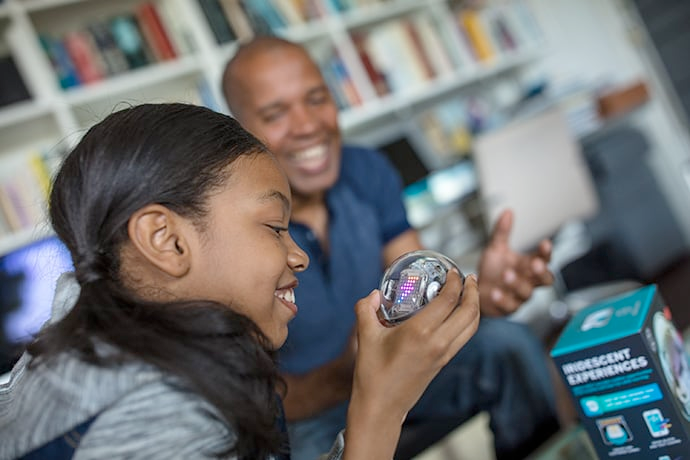Happy Wednesday. Your week is half over? 🙂 Today I have a few STEM stories. For example, how scientists figure out what dinosaurs could see, smell, and hear. Plus articles with links to software tools to use for coding. STEM/STEAM robots that would make great holiday gifts. And the history of pens in general and ballpoint pens in particular. I also found a great photograph on social media. It proves electric scooters are over a hundred years old, not a new invention.
How Did Dinosaurs See, Smell, Hear and Move?
How dinosaurs thought, saw, heard, smelled, and moved is impossible to know. Instead, we have educated guesses based on skeletons. Over millions of years, the soft parts of dinosaurs disappeared. Left behind are endocasts, the hollow shape left behind of their craniums or heads. To make things more interesting, dinosaur heads had a mix of brains and organs to smell, hear, and taste.
In 2023, two scientists determined that T-Rex had brains with as many neurons as baboons. But because we don’t how much space T-Rex organs for smell and taste took up in their heads, it’s still an educated guess.
True or not, their research prompts some interesting questions. If you were a T-Rex, could you smell dinner before you saw it? And, if today we believe elephants call each other by name, could dinosaurs do the same? We think of dinosaurs as toys or villains in scary movies. The research makes dinosaurs more flesh and blood. More like us and the animals in our world.
This Scientific American article describes how scientists measure the physical capabilities of dinosaurs.
How Did Dinosaurs See, Smell, Hear and Move? | Scientific American
https://www.scientificamerican.com/article/how-did-dinosaurs-see-smell-hear-and-move/
You Edit Code with What?
Having coded websites since around 1995, I joke that real men and women code with Notepad. 🙂 Obviously, life has become more complicated. Coding by hand with a bare bones software tool like Notepad, TextEdit, or vi deprives you of helpful tools.
Today, software used to code software are called IDEs, or Integrated Development Environments. They include lots of useful tools. For example, colored highlighting to make sense of your code. Auto completion surfaces possible functions, variable names, and other details as you type. Then there’s project management tools to organize code and folders as you work. And version control software built in. Of course, these days there’s AI. Programming and AI is a totally different topic, however.
Choosing tools is interesting. If you’re on your own, you get to pick the tool that works for you. If you work in a software development shop, you use what everyone else uses. In some cases, programmers use one tool at work and another tool at home. The latter choice is personal preference.
Here are software editing tools to look at. Aside from adding AI, which most tools have these days, there’s not a lot of new IDE software to consider. And most are robust with lots of tools to make your coding life easier.
IDE
https://en.wikipedia.org/wiki/Integrated_development_environment
Visual Studio
https://visualstudio.microsoft.com/
Sublime
https://www.sublimetext.com/
PyCharm (JetBrains)
https://www.jetbrains.com/pycharm/
Notepad
https://notepad-plus-plus.org/
Komodo IDE (ActiveState)
https://www.activestate.com/products/komodo-ide/
IntelliJ IDEA (for Katlin and Java languages)
https://www.jetbrains.com/idea/
Python IDEs and Code Editors (Guide)
https://realpython.com/python-ides-code-editors-guide/
Best Python IDE and Code Editors
https://codinginfinite.com/best-python-ide-code-editors-top-10/
PhpStorm
http://www.jetbrains.com/phpstorm/
Nova (Mac)
http://www.panic.com/coda/
BBEdit (Mac)
http://www.barebones.com/products/textwrangler/
STEM Holiday Gifts: Robots
Since the fall of 2014, I’ve published an annual holiday STEM/STEAM gift guide. This fall, I want to publish items in these Wednesday emails. People shop the holidays at different times. And besides it’s never too early, right?
The past two Wednesday emails have shared ideas for holiday STEM gifts: books, magazines, and secret codes. Today I want to talk robots.
Robots are fun to build for many kids. These robots also can be programmed to move around rooms, perhaps through an obstacle course, as a fun way for kids to learn programming. They’re also fun for parents to try with their kids or for older kids to master on their own. And there’s a few robots for younger kids PreK to 2nd grade that don’t require screens.
Sphero Indi
Designed for PreK to 2nd grade kids, this new Sphero robot teaches STEM skills without the need for a computer screen. Cards are used to direct the robot.
https://sphero.com/pages/sphero-indi
Botly
Botley introduces coding in an easy, friendly way. Children as young as 5 can learn to code with Botley is ready to use right out of the box – he’ll have kids coding in minutes. He’s also 100% screen-free, and the only coding robot that includes a 45-piece set! Botly can detect objects and avoid them, follow looping commands, navigate obstacle courses, follow black lines. He can teach conditional logic and other basic STEAM concepts.
https://www.learningresources.com/botleyr-the-coding-robot
Little Robot Friends
These small fun robots are very friendly and accessible, an easy way to get kids interested in coding and electronics. Each has their own personality. These cute little robots respond to light, touch, voice, and infrared inputs. They also blink, beep, and buzz.
https://littlerobotfriends.com/products/all-new-cubby-robot-kit
https://littlerobotfriends.com/products/paperbot-kit-2-0-single-pack
Sphero RVR
RVR is Sphero’s revolutionary take on the programmable robot — drivable right out of the box, packed with a diverse suite of sensors, and built for customization. Utilizing an expansion port, you can connect 3rd party hardware like Raspberry Pi, Arduino, BBC micro:bit, and more. RVR is a mobile platform for everyone from beginners to elite hackers, educators, and students. Great alternative to Lego Mindstorms which also is worth looking at. And check out Sphero Bolt, too.
https://www.sphero.com/rvr
DJI RoboMaster S1
The most expensive and expansive robot includes 40+ components that lets you explore science, physics, artificial intelligence (AI), and much more. It’s also fun to play with.
https://www.dji.com/robomaster-s1
Dash and Dot
These cute round robots from the Wonder Workshop are for kids elementary school age. Kids play with them to have fun and learn about technology. The Dash and Dot robots can be programmed with Blockly, a fairly easy language to master like Scratch. With Blockly you create a step, for example, play a sound, then define the sound as a lion roar. The combination of steps determines how the robot will move, when it will move, and what it will do. Also check out their
Cue robot!
https://www.makewonder.com/robots/dash/
https://www.makewonder.com/robots/cue/
LEGO Mindstorms
Take the LEGO idea — easy to snap together parts to build things — and add icon based programming, wheels, legs, and other mobile pieces and you have LEGO Mindstorms. While you can build simple robots, it’s more fun to build more complicated robots to do things and perform tasks. They can respond to touch and be controlled by a remote control. Mindstorms also includes an active online community with lots of ideas to try.
https://www.lego.com/en-us/themes/mindstorms/about
Cubetto
This robot requires no computer screens, only play. Program the Cubetto robot with touch, pressing down block shapes in order to tell the robot what to do, in what order, and when. You also don’t need to know English, or any language, to make the robot move. It’s a clever idea geared towards young kids. However, adults might find it fun to figure out, as well.
https://www.primotoys.com/
Ozobot
Two small robots, Evo and Bit, provide a deceptive amount of learning opportunities, creativity, and fun. They also have coding without screens robots for young kids.
https://ozobot.com/
Makeblock mBot
This robot lets you program with Scratch and Python languages. In addition to all the typical robot features.
https://www.makeblock.com/pages/mbot-robot-kit
Robo Wunderkind
This modular robot from Austria snaps together to make simple to complex robots, from a flashlight to a rolling vehicle that solves mazes. Includes free apps to program their robots. Geared towards teachers and classroom use.
https://robowunderkind.com/
The History of Pens
With computer keyboards, it’s easy to believe pencils and pens are rarely used. Their purpose replaced by keyboards. But both are still useful. And pens have been around for at least 3000 years. Bamboo reeds pressed into clay tablets in Sumeria are the first known pens. But Chinese, Egyptian, and other cultures made the same discovery. You can write by pressing a pointed stick on to a softer surface. And you can go back further 40000 years to cave paintings. They used bone pens to scratch paint colors on to stone cave walls.
What’s more modern are ballpoint pens. They appeared in 1895. Inventors wanted a self-feeding pen that did not need to refill ink into a pen. Ballpoint pens didn’t work well until Lázló Bíró patented a design in the 1930s. His design is what we use today. The bottom of the pen has a socket that holds a loose moving ball. Ink in the pen body flows down and around the ball. Press the pen down, the ball pushes up into the pen, and ink flows out on to a writing surface.
A self-feeding pen also uses capillary action. If you stick a straw in a half full glass of water, you’ll notice the water in the straw is higher than the water in the glass. Water molecules use a surface, the straw, to climb a little higher than the water outside the straw. It’s the same action that plants use to get water from their roots to their leaves.
Ingenious Engineering: Ballpoint Pens
https://www.delve.com/insights/from-quills-to-precision-the-ingenious-engineering-behind-ballpoint-pens
The History of Pens
https://www.executivepensdirect.com/en-us/blogs/help-advice/the-history-of-pens
The History of the Pen: A Comprehensive Timeline
https://www.logotech.com/blog/post/the-history-of-the-pen-a-complete-timeline
Pen
https://en.wikipedia.org/wiki/Pen
https://en.wikipedia.org/wiki/Ballpoint_pen
Who Invented the Ballpoint Pen?: A Brief History
https://www.dayspringpens.com/blogs/the-jotted-line/who-invented-the-ballpoint-pen-history
The cheap pen that changed writing forever
https://www.bbc.com/future/article/20201028-history-of-the-ballpoint-pen
This Week
Our Sunday email this week will have fun often offbeat links about how video games can improve mental health, college students who figured out how to use solar power to power EV chargers, an obstreperous AI model that modified its code to complete a task, humpback whales that make and then use tools, and Costco apparently will give out groceries if you turn in your old electronics, and more. Look for the email this Sunday.


